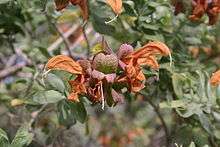Salvia africana-lutea
Salvia africana-lutea (beach salvia, dune salvia, golden salvia, bruin- of sandsalie, geelblomsalie) is a shrubby evergreen perennial native to coastal sand dunes and hills on the coast of the Western Cape, Eastern Cape and Northern Cape in South Africa. It has numerous woody stems growing to more than 1 m in height and width, with sparse grey-green leaves. The flowers start out as a bright yellow, turning into a rusty color, with the dark rusty-colored calyx persisting long after fruiting begins.[3]
| Salvia africana-lutea | |
|---|---|
 | |
| Scientific classification | |
| Kingdom: | Plantae |
| Clade: | Tracheophytes |
| Clade: | Angiosperms |
| Clade: | Eudicots |
| Clade: | Asterids |
| Order: | Lamiales |
| Family: | Lamiaceae |
| Genus: | Salvia |
| Species: | S. africana-lutea[1] |
| Binomial name | |
| Salvia africana-lutea[2] | |
| Synonyms | |
|
Salvia aurea | |
Traditional use
S. africana-lutea was used by early European settlers to treat colds, tuberculosis, and chronic bronchitis. Traditional indigenous healers use it for respiratory ailments, influenza, gynaecological complaints, fever, headaches and digestive disorders.[4]
Notes
- PHYTOTHERAPY RESEARCH Phytother. Res. 20, 427–437 (2006) Published online 18 April 2006 in Wiley InterScience (www.interscience.wiley.com) doi:10.1002/ptr.1898 REVIEW The Pharmacological Effects of Salvia species on the Central Nervous System
- PHYTOTHERAPY RESEARCH Phytother. Res. 20, 427–437 (2006) Published online 18 April 2006 in Wiley InterScience (www.interscience.wiley.com) doi:10.1002/ptr.1898 REVIEW The Pharmacological Effects of Salvia species on the Central Nervous System
- Clebsch, Betsy; Barner, Carol D. (2003). The New Book of Salvias. Timber Press. p. 28. ISBN 978-0-88192-560-9.
- Journal of Ethnopharmacology Volume 119, Issue 3, 28 October 2008, Pages 664-672 Ethnobotany in South Africa doi:10.1016/j.jep.2008.06.030 Review South African Salvia species: A review of biological activities and phytochemistry G.P.P. Kamatoua, N.P. Makungab, W.P.N. Ramogolab and A.M. Viljoena